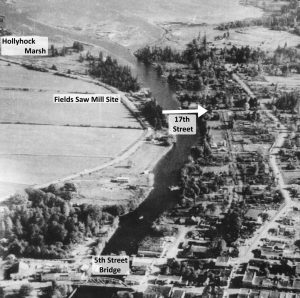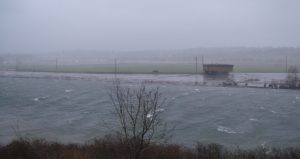Project Watershed and the Estuary Working Group have been developing restoration possibilities for the Field Sawmill site since 2009. “It is our belief that this property has the potential to become a highlight of a restored K’ómoks Estuary, itself a signature feature of the Comox Valley” states Don Castleden, Chair of the Estuary Working Group.
The sawmill that was located on this site in 1949 once served as an economic mainstay of Courtenay, however, that period was not without its cost to the health of the estuary, especially to our five major salmon runs. In fact, a governmental report made in 1976 Comox Harbor and later referenced in an article in the Comox District Free Press in 1977 stated that our estuary is one of the richest in Canada and the saw mill and log booming should be relocated. The sale of the sawmill site presents an opportunity to mitigate the damage done and to do what is humanly possible to restore salmon runs as well as other flora and fauna once abundant in the Estuary.
“Although we realize that the price at the moment is prohibitive we have encouraged the City to work with Interfor to acquire this property with a view to restoring its natural habitat. This could be a symbol of the commitment of the community to protect this important feature. Project Watershed has offered to work with the City and the community to help raise the money needed to purchase and restore this site” reports Paul Horgen, Chair of Project Watershed.
“The Chief and Council of the K’ómoks First Nation support the conceptual ideas presented by Project Watershed” states Cory Frank the K’omoks First Nation representative on the Estuary Working Group.
A Restored Sawmill Site
- The sawmill site can be planted with indigenous plants and trees and would eventually blend in with Hollyhock Marsh with its beautiful stand of Sitka spruce which lies just south of the property.
- A small stream can be created on the property that would connect the Dyke Slough to the river providing safe passage for migrating salmon in the Courtenay River (a channel is illustrated in the diagram accompanying this article). This channel would be too shallow for seals and therefore would alleviate predation and provide refuge for young salmon.
- A riparian buffer and salt water marsh can be incorporated into this new stream and would provide rearing habitat as well as pools for migrating salmon fry that need to ‘hold over’ while they adjust to salt water before striking out into ocean waters. This restoration would tie in with the existing salt water marsh and slough adjacent to Hollyhock Marsh, an area which has been determined to be one of the most productive habitats for salmon in the estuary, of which there are very few.
- Salt marsh could be planted in the area and would increase feeding and breeding grounds for bird species, act as a nursery for fish, filter and store pollutants from urban sources, anchor sediment and sequester carbon.
- The steel sheet piling at the river’s edge of the property can be removed and naturally sloped banks restored, similar to Hollyhock Marsh. These banks could be planted with indigenous bushes to stabilize the banks and protect the area during floods. Removal of the steel sheet piling would greatly improve the river for salmon survival as seals currently use the corrugated feature of the piling to trap their salmon prey.
- The concrete and pavement currently on the Sawmill Site can be removed and replaced with park space and walkways making the area accessible to the public for recreation, education and tourism. A bridge over the proposed creek would provide an ideal site for viewing salmon during their migration. One of the walkways could join with the walkway being planned by the Regional District between the Rotary Viewing Platform and Hollyhock Marsh. Kiosks, small vendors, interpretive signs, and benches would create an impressive gateway to the estuary.
In addition to the Estuary Working Group’s vision for a restored property, several professionals have reviewed the issues associated with developing this property for commercial purposes. It is important to note that any development would have to contend with:
- height restrictions due to the Air Park and floatplane operations on the river. Any building on the property will have to be assessed by NAV CANADA and Transport Canada for potential impacts to the Air Navigation System and for marking and lighting requirements.
- rising sea levels, storm surges, and flood waters as a result of severe weather events are to be expected in the future. Flood waters even now inundate the sawmill site during severe upland flooding and storm surges on the Strait. Provincial officials are now advising municipalities to plan for a minimum one metre rise in sea levels. It is estimated that this can result in much higher threat during the highest tides and extreme weather events. The best defences under these severe conditions are natural barriers – shrubs, trees, and aquatic plants that absorb the energy of ocean waves and fast flowing waters.
- insurance issues as there is every likelihood that buildings in floodplains will be uninsurable.
- setbacks which may be required for any building from both the natural shore and from the highway. When setbacks are factored in, the usable land may be very limited.
It also appears that the steel sheet piling along the west side of the property has encroached on the river and is a major hazard for salmon.
Acquiring this property for the benefit of all citizens will be a major undertaking but there are ways environmental groups, the community, local government, and local businesses can work together to achieve this goal. “We believe the community will rally behind this initiative and support the effort with volunteer time, money and materials” says Don Castleden. Possible tax deductions may be granted to the vendor and carbon offsets may be available to assist in the cost of restoration work. Funds can also be solicited from conservation trusts that support the restoration of estuaries.
The Project Watershed and the Estuary Working Group remain committed to assisting in this restoration. It will be a tangible way to follow through on our commitment to Keeping the Estuary Living.





